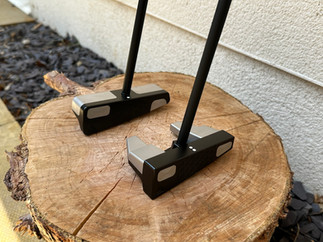In-Depth Review of the BGT Paradox Putters: What You Need to Know
- keithfmuir
- Jun 19
- 7 min read
Updated: Aug 18
Now also available on my new Substack page HERE
Getting the chance to review these putters is a bit of a coup for the blog. Putter nerds like me will likely already know about Breakthrough Golf Technology and their revolutionary "Stability Shaft". That shaft has been on the market for several years and has found many fans (and imitators). It was one of the original extra-stiff, low/no-torque putter shafts and uses an innovative multi-material design. Several putter companies offer the Stability shaft as an upgrade option, and it's also a popular after-market upgrade. It's a brave decision to go into competition with your customers and release a putter of their own. They must be convinced they've got something that can stand out in an increasingly crowded zero-torque marketplace, and that makes it worthy of review. Thanks again to Adam at Auchterlonies for giving me the opportunity.

Design and technology - you don't see a head like this every day!
When I was offered the chance to review these putters, I immediately spent some time geeking out on the BGT website and reading up on the technology. I'll try to provide a layman's interpretation in this review, but if you want more details, please follow this LINK to their website. For review, I had the blade putter fitted with the Stability shaft and zero-taper grip along with the mallet, which came with the basic graphite shaft and the Garsen grip. They were in standard 35" length and 70° lie angle.
The team at BGT have put some serious brain power and a lot of thought into the design of this putter. The unusual head shape and weight distribution are the key differentiator. Where other zero-torque putters are simply spin-balanced (see all the "revealer" videos), the Paradox is also swing-balanced, which makes it more biodynamically efficient when swung. BGT claim it is the only putter that will stay square to your swing path. They call it "Principal Axis Technology" and hold a patent over it, so don't expect imitators.
That swing balance is achieved through the unusual shape and weighting of the head, with the high toe weight and low heel weight. While that makes it look strange face on (or when looking from behind), once you get the putter into the address position, it is far less noticeable. That is particularly true of the blade, while the cavity in the mallet and the way the shaft joins make it a bit more noticeable.
With the other ZT putters I have tried, I've been disappointed with the way they feel when they hit the ball and I have struggled with pace control. I was pleased to see that these heads have a milled face. Feel is totally subjective, but my preference is for milled face putters, so hopefully these will be more familiar.
Performance: Will these ugly ducklings become swans on the green?
I put these putters through the same tests as my previous reviews, consisting of 6 putts, repeated 3 times, from 3', 6', 9', 12' and 15', then a lag test from 30' and finally a start line test from 6'. The same tests were completed with my Atlanta to provide a baseline for comparison. The results made for interesting reading.
Atlanta | BGT Blade | BGT Mallet | |
3 feet | 6 | 6/5/5 | 6/6/6 |
6 feet | 6 | 5/5/4 | 4/4/5 |
9 feet | 4 | 3/6/5 | 4/2/1 |
12 feet | 3 | 3/4/4 | 2/1/0 |
15 feet | 3 | 2/2/1 | 3/1/3 |
30 feet to 3 feet | 5 | 5 | 3 |
Start line drill | 5 | 2 (left bias) | 2 (left bias) |
To put these results into context, I've included an extract from "Every Shot Counts" by Mark Broadie regarding putting stats. These stats are something you should keep in mind when putting, as they are excellent for managing your expectations.

The performance of the blade from 9 and 12 feet was nothing short of remarkable. The ball just kept falling in the hole! To hole 6 from 6 and then 5 from 6 from 9' is extremely impressive. Once I got comfortable with it, it really did perform well. The same couldn't be said for the mallet, which produced a much more ordinary performance. I struggled with strike, pace and distance. There's a significant difference between the basic graphite shaft and the more expensive Stability shaft, with the blade feeling much nicer through the stroke. The same shaft in both heads would have been a fairer comparison. I was also having a good day with the Atlanta, and it was performing much better with its new SuperStroke grip installed!
The lag test was interesting, given I've struggled with other ZT putters, but the BGT blade was much better (the mallet less so). Is it the milled face, is it the Stability shaft, or is it the combination of both? Given the performance with the mallet, I have to conclude that the shaft choice makes the difference.

I found the blade much easier to align than the mallet, and think that may be due to the blade having less onset. It looks more like a SeeMore in that regard, and maybe I should reassess my prejudice against their centre shafted models? I think my issue with them is that the alignment line is above the shaft rather than to the side, as it is with the BGT. I felt very comfortable setting up to hit a putt with the BGT blade. I didn't like the double dots on the mallet head, especially combined with the bulky way the shaft joins the head. It was just more distracting, and I found it harder to align.
Pros and cons
Cost: These are expensive putters! The price starts at £499 for the graphite shaft and increases to an eye-watering £699 with the Stability shaft. Having used both shafts, I would only want to buy the Stability option. To be fair to BGT, that pricing is similar to L.A.B., where the base OZ.1 starts at £449, the face insert is £499, the Accra shaft adds £100, Gears £175, and TPT £380. So, Paradox is expensive, but not ridiculous.
Customisation: Limited options. The standard graphite shaft allows no customisation other than length. Going through the BGT website, taking the Stability shaft option also allows you to adjust the lie angle up and down by 3°. There is no customisation of alignment available, just the dots.
Grips: At this price point, I would have thought BGT would at least offer some alternative grip options. I found the zero-taper grip to be a bit too thick, and I didn't like the Garsen option with its unusual shape. As they don't use a press grip, it will be easy to change it yourself, but more options would be appreciated. If I've just paid £699, I don't think I should be paying more to change the grip.
Head Covers: I'm a big fan of magnetic closures. These feel well-padded and are secure when in place, but it can be awkward getting the odd-shaped heads into them.
Performance: It's hard to argue with how well the blade performed, even with a grip that I didn't like. I think the Stability shaft brings out the best in that head, and I would like to have tried the mallet with it too for a fairer comparison. I liked the milled head and lack of insert on both models and thought they felt excellent. They also provided good audible feedback on the quality of the strike, making it easy to tell if you hit the centre.
Blade vs Mallet: In this test, the blade significantly outperformed. I preferred how it looked at address, found it easier to align, and certainly holed more putts with it. All the other ZT putters I have tried have been mallet heads, and I wonder if there is something about their shape, their increased level of on-set and the way the shaft generally enters the head that puts me off them? With that in mind, there are some other ZT blades that I would like to try at some point: L.A.B Link, Bettinardi Antidote and Axis1 Shadow B.
Is it the shaft or is it the head? That's a difficult question to answer, as I would need to try both heads with both shafts to provide a better answer. The head design is different from any putter I've tried before. I've used "high toe" models, but never anything to this degree and with this style of weighting. Unquestionably, the mallet performed worse for me than the blade in this test. Is that the head or is it the shaft? Perhaps one conclusion from this test is to install a BGT Stability Shaft in my Atlanta and see how that performs.
Conclusion: Would I buy one?
Regular readers know that I've tried a lot of putters in my time (and I've got more reviews coming soon). If you saw the Tangent stats in the Spider 5K review (link), then you also know that my putting performance is good with my current putter. However, I am seriously impressed with the performance of the BGT Blade with the Stability shaft.
I think the shaft makes a considerable difference, and on the results of this test, I would not buy either head with the basic graphite option. Ideally, I would try the mallet with the Stability shaft to see if that improved its performance. There is a lot of technology at play here, and I think it works best when used together.
During this test, the blade putter was excellent and the best-performing putter I've tried in a long time. I've never holed 6 from 6 from 9 feet before with any putter, and I almost did it twice with this one! On some of the other tests, the Atlanta got similar results, but if money were no barrier, given the overall results, I would buy the blade with the Stability shaft (and change the grip).
Maybe zero-torque putters can work for me after all?
Finally, if you've read this far and enjoyed the post, then please consider subscribing. It doesn't cost you anything, but it encourages me to keep writing!
Other putter posts:
TaylorMade Spider 5K ZT - here
L.A.B. DF3 after the honeymoon - here
SeeMore M7 Tour - here
























